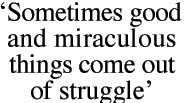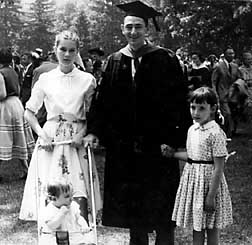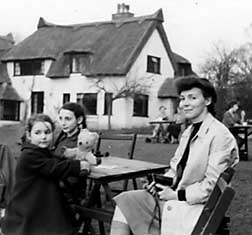|
VOICES OF NEW ENGLAND - - PHOEBE STONE |
November 16, 1997 |
|
|
Middlebury, Vt. -- Painter Phoebe Stone and her whimsical art are finding a growing audience with "When the Wind Bears Go Dancing," the first children's book she has both written and illustrated. Stone's pastel drawings for the book also hang in an exhibit at the DeCordova Museum in Lincoln, Mass. But Stone, daughter of acclaimed poets Walter and Ruth Stone, has not always led a charmed existence. Her father committed suicide when she was 11, leaving the rest of the family to struggle with poverty. Stone recently spoke with Globe correspondent Heather Stephenson about how her life has inspired her work, some examples of which appear at right; an edited excerpt of her remarks follows. |
|
My father was a professor at Vassar College. It was a really wonderful place to grow up. Vassar is made up of these big, castle-like buildings and all sorts of clipped, shaped hedges. It's a huge campus. I had the freedom to ride anywhere I wanted on my bicycle in this unbelievably lovely and magical kind of environment, from kindergarten until fifth grade. Both of my parents were very creative. My father was publishing fiction in The New Yorker and my mother was a poet. I was the artist in the family, and everything I did they loved. My mother was always giving readings, or my father was giving poetry readings. I heard words nonstop, beautiful words, wonderful words from both of them. I feel like I'm made out of their words somehow. |
In this picture I'm with my sisters and father at a Vassar College Commencement. I'm on the right and my sisters Marcia and Abigail are on the left. |
|
In the summer of 1958, before my father killed himself, we'd gone over to England for his sabbatical -- my sister and I had little doll suitcases with us and dolls, I remember. We went on the Queen Elizabeth. It was a beautiful, dazzling floating hotel, and we had tea on the deck, wrapped in woolen blankets. We played shuffleboard with the blue sea sort of placid, and we met friends and had a wonderful time. And when we came home, after my father had died, it was March and the weather was dangerous. This time it was on the Queen Mary, not the Queen Elizabeth, and all the portholes were all locked up and closed. I remember looking into the room where the swimming pool was -- it was locked and off-limits -- and there was water crashing from one end of the pool to the other, this massive amount of water smashing against the sides and almost leaping up into the air. The ocean was so rough that it was almost impossible to walk down the halls. |
|
That's about how it was. We were steering through a very difficult time. We hurried back, hoping to come home and have everything be all right. It was just chaos. My father did have a novel that was due. He had the advance and he was probably struggling to write it. But we're not really sure what happened or why. It's an unanswered question. I think sometimes good and miraculous things come out of struggle. I think I came to understand the shortness of life, that life is fragile. maybe that's what drives me to work so hard, or long to do something significant. Maybe it's helped me have more discipline. |
|
|
That was a long time ago. Of course I'll never be entirely the same person that I might have been. But you repair. The fabric may have a little lumpy, bumpy area where it's a little different as a result of the experience, but it's repaired. And when you look at the whole piece of fabric, it doesn't affect it; it's still beautiful. I was fast becoming a painter. Somebody had given me a paint by numbers set when I was about 12. I didn't want to use the numbers, but I used the little tubs and the canvas and I made my own painting. From then on, I was painting furiously in my room listening to Edith Piaf and Mozart and Bob Dylan. I'd get up in the morning in my flannel nightgown and start painting, and my nightgown was covered with splotches of oil paint. It was hard times, because it was basically a summer house that we returned to Vassar had offered housing that was part of my father's job, and when we didn't have that anymore because of his death, we only had this summer place up on a mountain in the town of Goshen. There wasn't central heating, so we had to haul in wood. I remember waking up in the morning and having snow on my pillow. It blew in through the crack under the window. We were quite poor, but not starving poor. We would get through. |
|
Goshen has its own magic too. My family was very close. We made up stories and we made plays. I had a little mimeograph machine -- my mother bought it at an auction -- and we made a newspaper with that. There was a brook that we played in, and the pine woods that we wandered down into. We were not lost in a blizzard of sorrow. We were bringing in wood and making paintings and writing poetry and living, you know. With my own life, I really wanted to do two things: I wanted to be a good mother, and I wanted to be a good artist. I didn't have a lot of time for anything else. I always wanted to do children's books. There's no new ground to cut with painting or sculpture; there's nothing new to be discovered. But with children's books, there's all this wonderful new stuff that can be done. I find it incredibly exciting. |
|
|
A lot of the symbols in "When the Wind Bears Go Dancing" were used in my fine art earlier -- the fuzzy coat, the huge flowers, the blowing curtains. I used to tell the story to my son Ethan when he was little. We had a lot of storms, so I used to tell him it was bears dancing in the sky and tigers playing tambourines. I didn't tell it in the rhyme then; I changed it later. In the text, I wanted to use words that sounded like the rain and the wind, and that would be fun for the parent to say aloud, like razzle and dazzle, and giggle and wiggle, and rumble and tumble. The book helps children get over their fear of thunder and lightning. It transforms something that might be scary into something fun. Which is what art does too; it takes something that's ordinary or average and transforms it into something joyful. |
|
That aired on Vermont Public Radio |
|
What Night Do the Angels Wander? Phoebe's Books | About Phoebe | News & Reviews |



